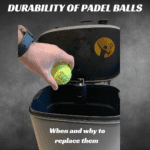This post may contain affiliate links.

If you are reading this you are probably already convinced that building padel courts on tennis courts is an option worth investigating. Seeing many tennis clubs converting some of their tennis courts to padel courts, I wondered about the implications and things to consider.
Space requirements (both in terms of surface area and height), foundation, and location are key considerations when converting tennis courts to padel courts. Location and foundation are more important for outdoor courts, while space requirements are more relevant for indoor courts.
Next, I will take you through each of the key considerations in greater detail so you know what to look for when building padel courts on existing tennis courts.
Required Space For Padel Courts
Padel courts have a smaller playing area compared to tennis courts. Besides the area outside the padel court is also smaller, compared to tennis courts. As a result, more space is available to construct padel courts.
The playing area of a padel court is 200 m2 (not allowing out-of-court play), while tennis courts are 593.1 m2. The total space requirements for both padel and tennis courts depend on the type of court.
If you want to know how many padel courts can fit on your tennis court(s) click the button to check out my other article. There I answer how many padel courts can fit into tennis courts in great detail.
Height Considerations For Padel Courts vs Tennis Courts
The minimum recommended height of indoor tennis courts are higher compared to indoor padel courts and overhead clearance is therefore generally not a problem when converting a tennis court to a padel court.
When building a padel court on an existing tennis court, height is another aspect to take into consideration. This is of course only the case for courts with any kind of roofing, albeit indoor or outdoor. Playing lobs is a common and effective tactic in padel, while this is less important in tennis. Therefore let’s look at the minimum height requirements.
According to the International Padel Federation (IPF), the minimum height for padel courts is 6 meters (19.7 feet). However, the recommendation is to have at least an unobstructed height of 8 meters (26.2 feet). For indoor tennis courts, the Internation Tennis Federation (ITF) recommends a minimum height (measured at the net) between the court and ceiling is 9 meters (29.6 feet). The minimum height for tennis courts is higher thus not posing a risk to the minimum height requirements for padel courts.
Light systems are usually part of the court construction for outdoor courts. The minimum allowed height for light projectors is 6 meters. However, if the light projectors are within the court, the minimum recommended height is 8 meters. These floodlights are used to ensure the court is properly illuminated while considering any overspill or nuisance to surrounding areas.
While we have covered the required space in length, width and height, let’s talk about some foundational stuff with concrete examples. (pun intended)
Foundation Considerations For Padel Courts vs Tennis Courts
The playing area of padel courts can be built on asphalt (or concrete), while a partial concrete foundation is required to secure the steel construction. Whether tennis courts are built on asphalt or concrete, they can relatively easily be converted into a padel court.
While the foundation is important for both indoor and outdoor courts, the weather elements (cold, wind, rain) make the foundation a bigger consideration for outdoor courts.
Foundation For Steel Construction Of Padel Court
If padel courts are laid on asphalt, only the steel court construction needs to be secured and mounted onto concrete. First of all, the ground needs to be excavated around the periphery of the court. This so-called concrete ring beam is made of reinforced concrete to support the load of the construction. This concrete beam runs along the court and is at a minimum, 30 cm wide and 30 cm deep, although 40 cm wide and 40 cm deep is recommended.
For areas in colder climates, there is an additional consideration when it comes to foundation. The concrete beam that holds the steel construction should be deep enough in the ground to prevent frost action. Therefore construction companies, recommend the foundation has a minimum depth of 45 cm (and even 1 meter for clay-type surfaces) . Another consideration is to allow the drainage of rainwater outside the concrete ring beam, especially for non-porous foundations of the playing area.
. Another consideration is to allow the drainage of rainwater outside the concrete ring beam, especially for non-porous foundations of the playing area.
Foundation For Playing Area Of Padel Court
While the playing area does not need to bear as much weight and impact, we can’t just put the artificial grass on top of the asphalt (without some good considerations). Therefore it is recommended to have a concrete layer of 12 to 15 cm and an additional coating before putting down that turf. This concrete layer should act as a drainage system for outdoor courts.
Nevertheless, it is possible to put the turf on top of the existing asphalt as long as it is a smooth and level surface that allows rainwater to be drained. However, this is less of a common practice.
Whether you add a concrete coating or not, there is less labor involved compared to a complete overhaul. If not all asphalt needs to be removed, the cost of converting such a court is lower.
Nevertheless, if you take foundational shortcuts during the construction phase, you are likely to end up paying extra when it comes to maintenance.
Let’s assume you want to start from scratch or want to get rid of the asphalt to build the padel courts from the ground up. In that case, you would excavate the full area and cast a concrete foundation. Sure, it might be easier to ensure that the surface is level and without cracks. But then again, additional labor results in higher construction costs for your padel courts. Nevertheless, if you take foundational shortcuts during the construction phase, you are likely to end up paying extra when it comes to maintenance.
Pick The Optimal Location For Your Padel Court
If you want to build padel courts on only a few of the existing tennis courts, then the next question is, where to put them? Assuming your goal is to attract as many people to padel or to revamp your club using padel, then location is key. Ideally, the padel courts would be visible from around the facility.
According to international guidelines, both outdoor tennis courts, as well as outdoor padel courts, should be placed in such a way that it minimizes the inconvenience of the sun for the players, meaning a north-south orientation. Nevertheless, a variation between north-northeast and north-northwest is allowed.
One possibility is to place it in the center of the facility to make sure anyone notices it. If this is not possible due to the current setup, at least ensure that anyone coming to your facility will need to walk past it. You can even change the walking area to ensure people need to walk past the padel courts and therefore will notice it.
What’s not to like about that?
Another effective option is to locate the padel courts as close as possible to the bar or social area without having the nuisance of the court. Oh and if you want to reduce noise nuisance for your padel court, check out this article. Padel is an attractive sport to watch, thus anyone enjoying their drink can also become a spectator of what’s going on on your padel court. What’s not to like about that?






